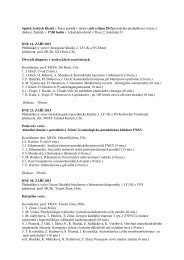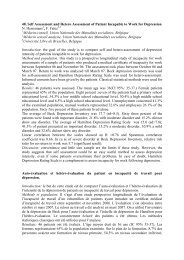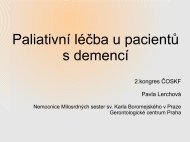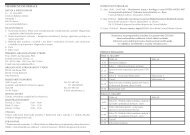ABSTRACTS â ORAL PRESENTATIONS - AMCA, spol. s r.o.
ABSTRACTS â ORAL PRESENTATIONS - AMCA, spol. s r.o.
ABSTRACTS â ORAL PRESENTATIONS - AMCA, spol. s r.o.
Create successful ePaper yourself
Turn your PDF publications into a flip-book with our unique Google optimized e-Paper software.
P42. ELUCIDATION OF CROSSTALK BETWEEN SENESCENCE AND APOPTOSIS<br />
Zuzana Nahacka, Gita Novakova, Ladislav Anděra<br />
Institute of Molecular Genetics of the Academy of Science of Czech Republic, Laboratory<br />
of Cell Signaling and Apoptosis, Prague, Czech Republic, nahackaz@img.cas.cz<br />
Senescence is irreversible cell-cycle arrest, where senescent cells stay metabolically<br />
active and acquire distinctive morphological and biochemical alterations (Bartek et al.,<br />
2007). Replicative senescence was described in normal cells as an intrinsic molecular<br />
programme that limits cell multiplication (Hayflick and Moorhead, 1961). Apart from<br />
aging, senescence in normal human cells can be induced by oncogenes such as activated<br />
H-Ras as a protective measure against tumorigenesis. Furthermore stress-induced or<br />
premature senescence is one of the major cellular response to chemotherapy and<br />
radiotherapy in solid tumors (Mirzayans et al., 2005).<br />
The other type of cell protection against tumorigenesis is apoptosis. In our study we are<br />
mainly interested in an elucidation of presumed crosstalk between apoptotic signaling<br />
and senescence-triggered rewiring the cellular signaling and metabolism.<br />
We induced premature senescence in primary (colorectal NCM460) and cancer cell<br />
lines (pancreatic PANC and mestohelial H28) with BrdU (20-100uM) treatment for 5-7<br />
days. Then using mainly flow cytometry we analyzed response of senescent cells to<br />
different apoptotic stimuli inducing extrinsic (Trail, Fas ligand) or intrinsic (mito-VES,<br />
staurosporine, campthotecin) apoptotic signaling and the expression profile of TRAIL-R1<br />
(Death receptor 4), TRAIL-R2 (Death receptor 5), TRAIL-R3 (Decoy receptor 1), TRAIL-R4<br />
(Decoy receptor 2), FAS and TNF receptors. In addition to drug-induced senescence<br />
we are currently testing recombinant lentiviruses with inducible (pLVX p16-T2A-p21)<br />
or constitutive (pCDH p16-T2A-p21), expression of cell cycle inhibitors p16 and p21<br />
proteins. We found that Fas expression has increased in the drug-induced senescent<br />
cells which is in agreement with recently published data (Crescenzi et al., 2011). These<br />
cells were also sensitized to FasL-induced apoptosis. Similarly, these senescent cells<br />
were sensitized to campthotecin and mito-VES triggered apoptosis. In contrast, DR4<br />
expression and sensitivity to TRAIL dropped in the senescent cells.<br />
References<br />
Hayflick, L. and Moorhead, P.S. (1961) The serial cultivation of human diploid cell strains.<br />
Exp Cell Res, 25, 585-621.<br />
Mirzayans, R., Scott, A., Cameron, M. (2005) Induction of accelerated senescence by<br />
gamma radiation in human solid tumor-derived cell lines expressing wild-type TP53.<br />
Radiat Res, 163, 53-62.<br />
Bartek, J., Bartkova, J., Lukas, J. (2007) DNA damage signalling guards against activated<br />
oncogenes and tumour progression. Oncogene, 26, 7773-7779.<br />
Crescenzi, E., Pacifico, F., Lavorgna, A. et al. (2011) NF-κB-dependent cytokine secretion<br />
controls Fas expression on chemotherapy-induced premature senescent tumor cells.<br />
Oncogene, 30, 2707-2717.<br />
138 Analytical Cytometry VII








